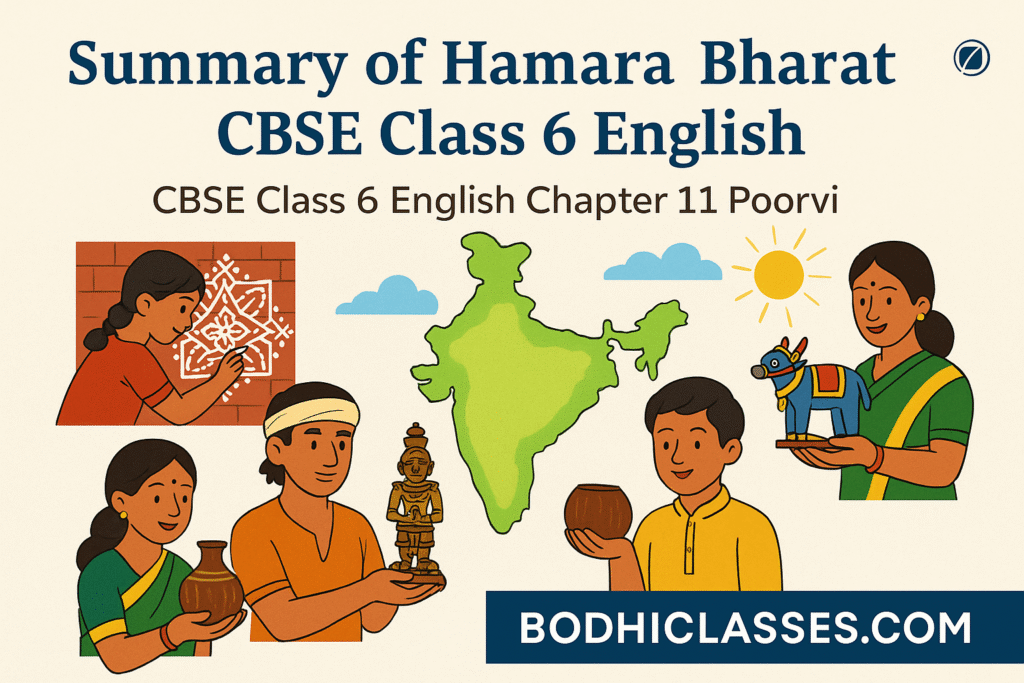Summary of Hamara Bharat CBSE Class 6 English offers a beautiful glimpse into India’s glorious cultural past and present. This chapter from Poorvi not only highlights India’s natural beauty and geographical wealth but also celebrates its vibrant traditions, folk art, and unity in diversity. Designed for Class 6 students, the lesson introduces readers to the “Ek Bharat, Shreshtha Bharat” initiative that strengthens national bonds through inter-state cultural exchange. From the rhythmic strokes of Aipan in Uttarakhand to the timeless charm of Dhokra metal craft in Odisha, the chapter is a colorful tribute to India’s incredible heritage. Let’s explore the key themes and summary of this inspiring chapter.

Summary of Hamara Bharat Cbse Class 6 English Chapter 13 Poorvi

The Summary of the Chapter:
Introduction:
The chapter Hamara Bharat – Incredible India! celebrates the rich and diverse culture of India, highlighting its traditions, geographical beauty, and unity in diversity. It emphasizes the need to preserve and promote India’s cultural heritage.
Bharat’s Cultural and Geographical Wealth:
India has been recognized as a land of wisdom and bravery. Since ancient times, travelers from around the world have been attracted to its diverse culture. The country is enriched with rivers, mountains, forests, and a wide variety of flora and fauna. The people of India live together in harmony, setting an example of unity in diversity.
Ek Bharat, Shreshtha Bharat:
The chapter introduces the Ek Bharat, Shreshtha Bharat initiative, which aims to strengthen national unity by fostering cultural exchanges between different states and union territories.
Traditional Art Forms of India:
- Aipan (Uttarakhand): A folk art drawn using white rice flour paste on brick-red walls, often during festivals and family functions.
- Dhokra Metal Craft (Odisha): A 4000-year-old technique of making metal figurines using clay, wax, and molten brass.
- Coconut Shell Craft (Kerala): An eco-friendly craft where coconut shells are polished and carved into decorative and household items.
- Kondapalli Toys (Andhra Pradesh): Handmade wooden toys depicting rural life, animals, and folk stories, made using softwood and natural dyes.
Ek Bharat, Shreshtha Bharat Programme:
This initiative encourages inter-state cultural exchange, promoting mutual understanding and unity among Indians. It showcases India’s diversity in language, food, art, festivals, and traditions, helping people develop a sense of shared identity.
Important Word Meanings and Terms from the Chapter: Hamara Bharat – Incredible India!
Key Vocabulary and Meanings:
- Unity in Diversity – The concept of different cultures, religions, and traditions coexisting peacefully in one nation.
- Heritage – Traditions, customs, and cultural values passed down from ancestors.
- Tradition – A long-established way of life or practice followed by people.
- Culture – The ideas, customs, arts, and social behavior of a particular society or community.
- Diversity – The presence of many different types of people, cultures, and traditions in one place.
- Handicrafts – Artistic items made by hand using traditional skills, such as pottery, painting, and weaving.
- Folk Art – Traditional art practiced by local communities, often passed down through generations.
- Sustainability – Using resources in a way that does not harm the environment or deplete them for future generations.
- Patriotism – Love, pride, and devotion towards one’s country.
- Geographical Features – Physical characteristics of a place, such as rivers, mountains, and forests.
- Biodiversity – The variety of plant and animal life found in a particular region.
- Ek Bharat, Shreshtha Bharat – A national program to promote cultural exchange and unity among states in India.
- Aipan (Uttarakhand) – A folk art created using white rice flour paste on brick-red walls during festivals.
- Dhokra (Odisha) – A traditional metal craft made using clay, wax, and molten brass.
2nd lot
- Coconut Shell Craft (Kerala) – A handicraft where polished coconut shells are shaped into decorative and household items.
- Kondapalli Toys (Andhra Pradesh) – Wooden toys painted with natural dyes, depicting rural life and folk stories.
- Geru – A type of red clay used as a natural color for paintings and designs.
- Sawdust – Fine particles of wood produced when cutting or carving wood.
- Biodegradable – A material that decomposes naturally without harming the environment.
- Enamel Paints – A type of paint that creates a protective and glossy finish on surfaces.
- Tamarind Seed Powder – A paste made from tamarind seeds used in traditional crafts for binding materials.
- Mutual Understanding – Learning about and respecting different cultures, fostering harmony and unity.
The Summary of Hamara Bharat CBSE Class 6 English reflects the true essence of India — a land of multiple cultures woven into one nation. Through vivid descriptions of traditional art forms and the purpose behind the Ek Bharat, Shreshtha Bharat programme, students are taught to value and preserve their cultural legacy. This chapter encourages young minds to feel proud of their country’s heritage and contributes to building a stronger, united, and more culturally aware India. For more such textbook solutions and summaries, stay connected with BODHICLASSES.COM.


